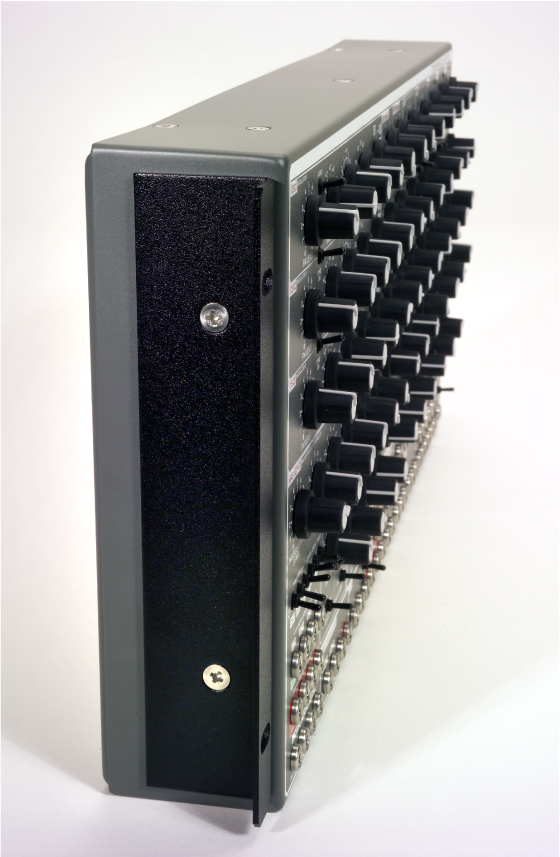Filter on ALL, SYNTH, DRUM, SAMPLER or MISC |
Total list currently 2405 items in 330 Brands |
Cwejman | S1-MK2 |
Description | The S1 is a semi-modular, analogue monophonic synthesizer. It is easy to get started with since it is prepatched for optimal use of its sound producing possibilities and eliminates the need for external connections between modules during use. Each module can be disconnected and used separately, e.g. to control or becontrolled by other instruments. This flexibility enables and simplifies experimentation with creation and reproduction of sound. The S1 synthesizer is an analog instrument (not including the MIDI Converter of course). Most parameters such as frequency, amplitude, resonance (Q-PEAK), attack time, decay time, etc. areadjustable via potentiometers on the front panel and can also be voltage controlled via respective CV inputs. The main voltage regulator is equipped with a highly stable reference circuit with a stability of 20ppm/deg C to guarantee long term stability. In addition, great attention has been taken to design of the oscillators to achieve the highest possible frequency stability; a carefully chosen compensation circuits has been designed by simulation tool and practically verified to achieve high stability throughout the entire temperature range. In addition to the application of know-how from the analogue field, modern simulation tools have been used to optimize and verify the characteristics and performance of all circuits inside the S1. Since the filters are among the most dominant sound processors in an analog synthesizer great effort have been taken in their design both in regard to the form of simulation and practical listening tests with the object of being able to offer two completely different types of acoustical characteristics in the LPF and MMF. Via countless testing and listening it was determined that the filters, in addition to the customary 12 and 24dB/octave slope, must also have a 36dB/octave slope. The difference between 24 and 36dB slope may seem to be slight but is highly pronounced to a listener and offers new and highly useful possibilities in sound modification. Envelope generators have been developed by simulation in a computer environment. All the parameters can be voltage controlled within a large time range; Attack, Decay, Release times are adjustable from 0.5 milliseconds (actually 350 microseconds) to 20 seconds. S1 is a so called semi-modular synthesizer which means that all modules, e.g. oscillators, filters, etc. are interconnected in a certain configuration.The configuration can be altered using patches. Conne ctions between the different modules can be broken and routed to other inputs or outputs. For example, to crossconnect the filters, the MULTI-MODE FILTER external audio input is connected to the LOWPASS FILTER audio input which can produce unexpected effects such as the generation of sub-octave tones. The list of possible configurations is, of course, very long so the following is a description of the constituent parts of the instrument, i.e. the modules. |
| Brand | Cwejman |
| Model | S1-MK2 |
| Device | Synth |
| Type | Desktop |
| Engine Type | Modular (Semi) |
| Engine | VCO |
| Voices (max) | 1 |
| Oscillators | 3 |
| LFO | 1 Sample & Hold, Saw Up, Square, Triangle |
| Noise | Y |
| Engine Detailed | 3 VCO. Pulse Variable, Saw Up, Sine, Square, Triangle, White Noise |
| Filter (VCF) | 2 6dB Slope, 12dB Slope (2-pole), 18dB Slope, 24dB Slope (4-pole), 36dB Slope , Band Pass, High Pass, Low Pass, Resonance |
| Envelope (VCA) | 1 ADSR |
| Keys | 0 |
| Key type | N/A |
| Velocity | N/A |
| Aftertouch | N/A |
| Midi | I-O-T |
| CV-gate | CV/GATE I-O |
| Produced: | 2004 |
| Legend: | Obvious | Y: Yes, N: No, N/A: Not Applicable | |
| VCO | Voltage Controlled Oscillator | DCO | Digital Controlled Oscillator |
| LFO | Low Frequency Oscillator | Sub | Sub Oscillator |
| VCF | Voltage Controlled Filter | VCA | Voltage Controlled Amplifier |
| Velocity | As with a piano, the harder you hit a key, the louder the sound, unlike most organs which always produce the same loudness no matter how hard you hit a key. | Aftertouch | Pressing a key after you activated it. Channel Aftertouch, no matter which key, it will send a Channel message. Poly Aftertouch, sends the pressure per key instead of the whole channel. |
| Values for OSC, LFO, Filter, Envelope are per voice unless stated otherwise. | |||




